Impacts of COVID-19 Pandemic Lockdown on Road Safety in Bangladesh
Abstract
1. Introduction
2. Literature Review
3. Methodology
3.1. Study Area
3.2. Data Collection and Preparation
3.3. SARIMA (Seasonal Autoregressive Integrated Moving Average) Model
- Time Series Decomposition
- Stationarity Test
- ACF and PACF Plots (Autocorrelation and Partial Autocorrelation Plots)
- Seasonal ARIMA modeling (SARIMA Modeling)
- Model Diagnosis
- Test for Error Estimates
- Forecasting
- Mean Error (ME)
- Root Mean Squared Error (RMSE)
- Mean Absolute Error (MAE)
- Mean Percentage Error (MPE)
- Mean Absolute Percentage Error (MAPE)
4. Results
4.1. Preliminary Analysis
4.2. Basic Time Series Plots
4.3. Test of Stationarity
4.4. Fitting Time Series Models (ACF/PACF PLOTS)
4.5. Model Selection
4.6. Model Diagnostics
4.7. Forecasting
5. Discussion
6. Conclusions
6.1. Policy Recommendation
6.1.1. Maintaining Safe Speed
6.1.2. Pedestrian Safety
6.1.3. Financial Support from the Government
6.1.4. Safety Campaign
6.2. Limitation
Supplementary Materials
Author Contributions
Funding
Institutional Review Board Statement
Informed Consent Statement
Data Availability Statement
Acknowledgments
Conflicts of Interest
Appendix A
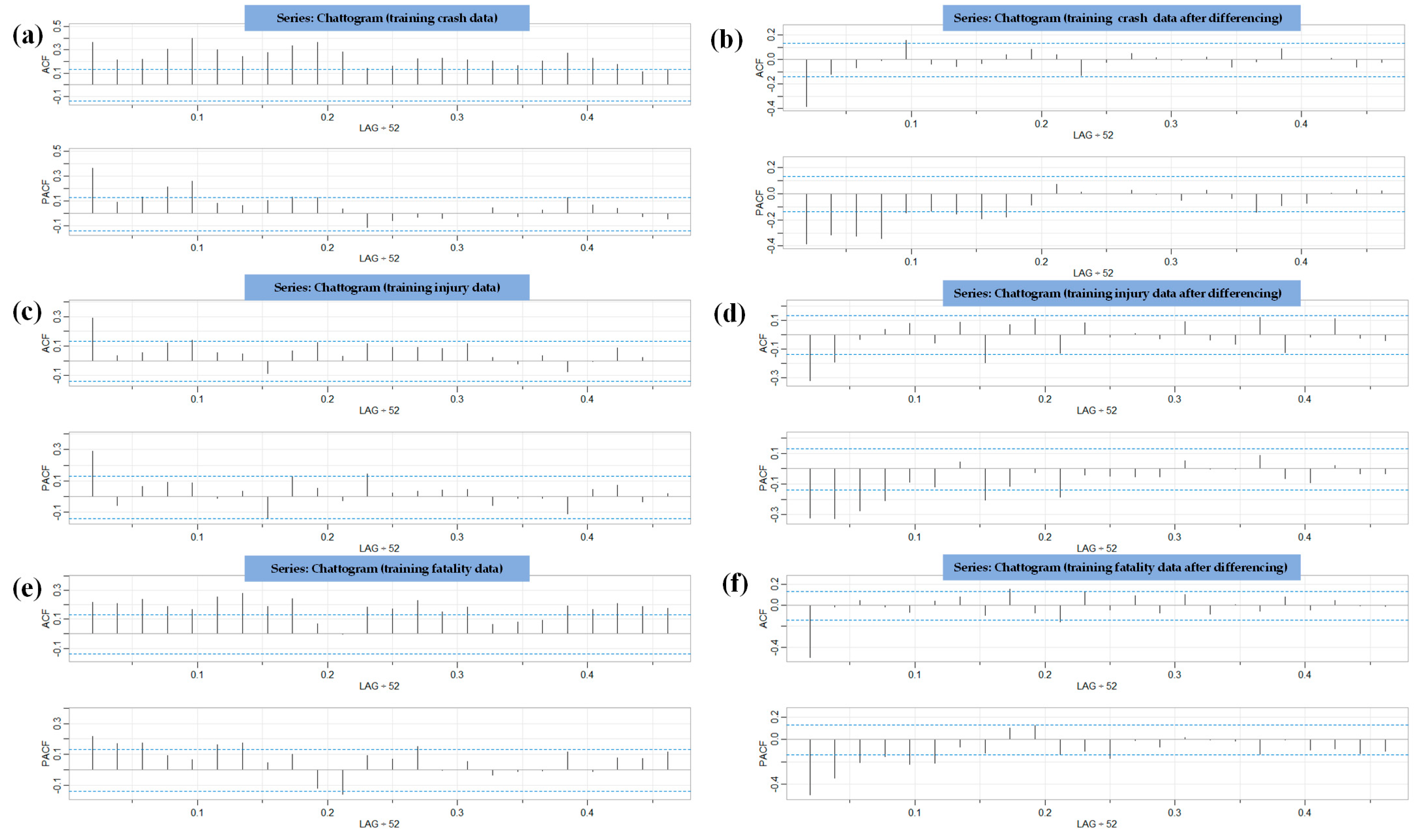
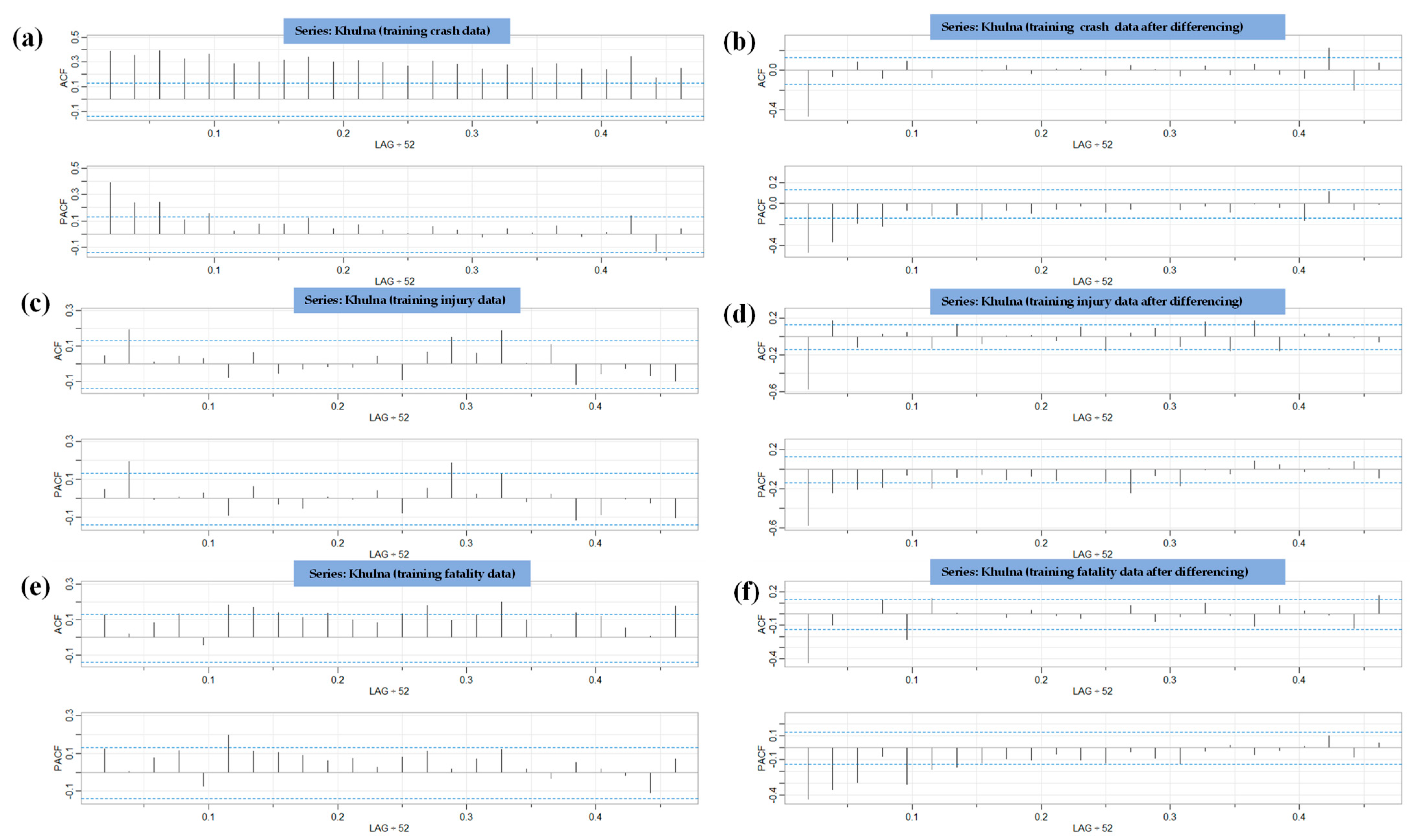
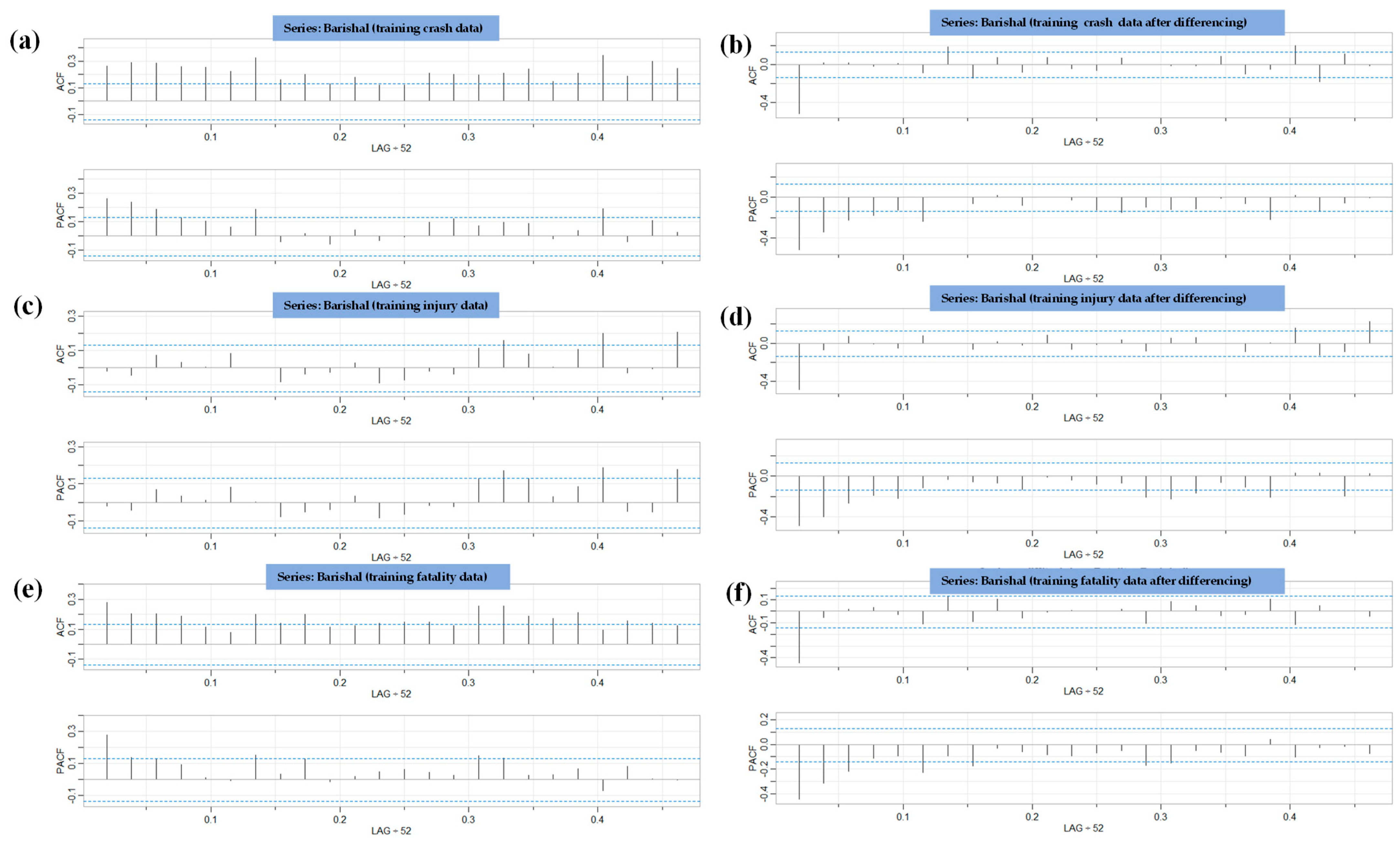

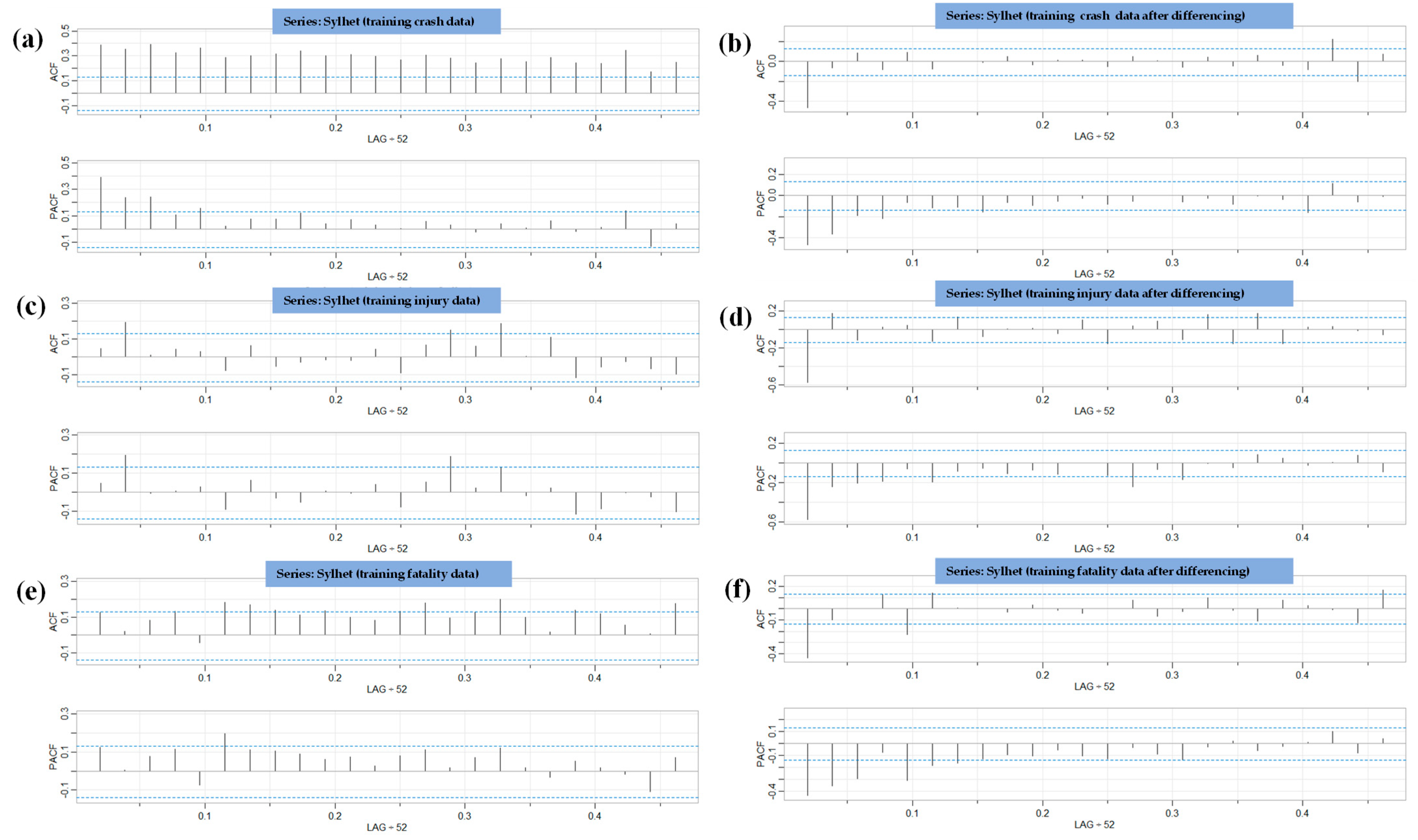


References
- Jiang, S.; Du, L.; Shi, Z. An Emerging Coronavirus Causing Pneumonia Outbreak in Wuhan, China: Calling for Developing Therapeutic and Prophylactic Strategies. Emerg. Microbes Infect. 2020, 9, 275–277. [Google Scholar] [CrossRef] [PubMed]
- WHO-Convened Global Study of Origins of SARS-CoV-2: China Part. Available online: https://www.who.int/publications/i/item/who-convened-global-study-of-origins-of-sars-cov-2-china-part (accessed on 20 October 2022).
- The Pandemic’s True Death Toll | The Economist. Available online: https://www.economist.com/graphic-detail/coronavirus-excess-deaths-estimates (accessed on 20 October 2022).
- Dong, E.; Du, H.; Gardner, L. An Interactive Web-Based Dashboard to Track COVID-19 in Real Time. Lancet Infect. Dis. 2020, 20, 533–534. [Google Scholar] [CrossRef] [PubMed]
- Musselwhite, C.; Avineri, E.; Susilo, Y. Editorial JTH 16—The Coronavirus Disease COVID-19 and Implications for Transport and Health. J. Transp. Health 2020, 16, 100853. [Google Scholar] [CrossRef] [PubMed]
- Wu, J.T.; Leung, K.; Leung, G.M. Nowcasting and Forecasting the Potential Domestic and International Spread of the 2019-NCoV Outbreak Originating in Wuhan, China: A Modelling Study. Lancet 2020, 395, 689–697. [Google Scholar] [CrossRef]
- Sekadakis, M.; Katrakazas, C.; Michelaraki, E.; Kehagia, F.; Yannis, G. Analysis of the Impact of COVID-19 on Collisions, Fatalities and Injuries Using Time Series Forecasting: The Case of Greece. Accid. Anal. Prev. 2021, 162, 106391. [Google Scholar] [CrossRef]
- Road Traffic Injuries. Available online: https://www.who.int/news-room/fact-sheets/detail/road-traffic-injuries (accessed on 20 October 2022).
- Islam, S.; Islam, R.; Mannan, F.; Rahman, S.; Islam, T. COVID-19 Pandemic: An Analysis of the Healthcare, Social and Economic Challenges in Bangladesh. Prog. Disaster Sci. 2020, 8, 100135. [Google Scholar] [CrossRef]
- Bangladesh Imposes Total Lockdown over COVID-19. Available online: https://www.aa.com.tr/en/asia-pacific/bangladesh-imposes-total-lockdown-over-covid-19/1778272 (accessed on 20 October 2022).
- Catchpole, J.; Naznin, F. Impact of COVID-19 on Fatal Crashes in Australia. In Journal of Integrated Mobility: New Knowledge Applications in Australasian Transport; ARRB Group Limited: Port Melbourne, Australia, 2020. [Google Scholar]
- Abdullah, M.; Dias, C.; Muley, D.; Shahin, M. Exploring the Impacts of COVID-19 on Travel Behavior and Mode Preferences. Transp. Res. Interdiscip. Perspect. 2020, 8, 100255. [Google Scholar] [CrossRef]
- Zhang, N.; Jia, W.; Wang, P.; Dung, C.H.; Zhao, P.; Leung, K.; Su, B.; Cheng, R.; Li, Y. Changes in Local Travel Behaviour before and during the COVID-19 Pandemic in Hong Kong. Cities 2021, 112, 103139. [Google Scholar] [CrossRef]
- Iqra, S.H.; Islam, S.; Huq, A. Factors Affecting Mobility Patterns during Official Lockdown Period in Bangladesh: A Case of COVID-19. J. Transp. Health 2021, 22, 101163. [Google Scholar] [CrossRef]
- de Vos, J. The Effect of COVID-19 and Subsequent Social Distancing on Travel Behavior. Transp. Res. Interdiscip. Perspect. 2020, 5, 100121. [Google Scholar] [CrossRef]
- Katrakazas, C.; Michelaraki, E.; Sekadakis, M.; Yannis, G. A Descriptive Analysis of the Effect of the COVID-19 Pandemic on Driving Behavior and Road Safety. Transp. Res. Interdiscip. Perspect. 2020, 7, 100186. [Google Scholar] [CrossRef]
- Saladié, Ò.; Bustamante, E.; Gutiérrez, A. COVID-19 Lockdown and Reduction of Traffic Accidents in Tarragona Province, Spain. Transp. Res. Interdiscip. Perspect. 2020, 8, 100218. [Google Scholar] [CrossRef]
- Barnes, S.; Beland, L.-P.; Huh, J.; Kim, D.; Barnes, S.; Beland, L.-P.; Huh, J.; Kim, D. The Effect of COVID-19 Lockdown on Mobility and Traffic Accidents: Evidence from Louisiana; Global Labor Organization (GLO): Essen, Germany, 2020. [Google Scholar]
- COVID-19 Lockdowns and Decline in Traffic Related Deaths and Injuries | IZA—Institute of Labor Economics. Available online: https://www.iza.org/publications/dp/13278/covid-19-lockdowns-and-decline-in-traffic-related-deaths-and-injuries (accessed on 24 October 2022).
- Gupta, M.; Pawar, N.M.; Velaga, N.R. Impact of Lockdown and Change in Mobility Patterns on Road Fatalities during COVID-19 Pandemic. Transp. Lett. 2021, 13, 447–460. [Google Scholar] [CrossRef]
- Sedain, B.; Pant, P.R. Road Traffic Injuries in Nepal during COVID-19 Lockdown. F1000Research 2021, 9, 1209. [Google Scholar] [CrossRef]
- Vandoros, S.; Papailias, F. Empty Streets, Speeding and Motor Vehicle Collisions during COVID-19 Lockdowns: Evidence from Northern Ireland. MedRxiv 2021. [Google Scholar] [CrossRef]
- Qureshi, A.I.; Huang, W.; Khan, S.; Lobanova, I.; Siddiq, F.; Gomez, C.R.; Suri, M.F.K. Mandated Societal Lockdown and Road Traffic Accidents. Accid. Anal. Prev. 2020, 146, 105747. [Google Scholar] [CrossRef]
- Adanu, E.K.; Brown, D.; Jones, S.; Parrish, A. How Did the COVID-19 Pandemic Affect Road Crashes and Crash Outcomes in Alabama? Accid. Anal. Prev. 2021, 163, 106428. [Google Scholar] [CrossRef]
- Catchpole, J.; Naznin, F. Impact of COVID-19 on Road Crashes in Australia. In Australian Road Research Board; ADVI: Sydney, Australia, 2020; pp. 1–8. [Google Scholar]
- Vingilis, E.; Beirness, D.; Boase, P.; Byrne, P.; Johnson, J.; Jonah, B.; Mann, R.E.; Rapoport, M.J.; Seeley, J.; Wickens, C.M.; et al. Coronavirus Disease 2019: What Could be the Effects on Road Safety? Accid. Anal. Prev. 2020, 144, 105687. [Google Scholar] [CrossRef]
- Chand, S.; Yee, E.; Alsultan, A.; Dixit, V.V. A Descriptive Analysis on the Impact of COVID-19 Lockdowns on Road Traffic Incidents in Sydney, Australia. Int. J. Environ. Res. Public Health 2021, 18, 11701. [Google Scholar] [CrossRef]
- Prasetijo, J.; Zhang, G.; Jawi, Z.M.; Mahyeddin, M.E.; Zainal, Z.F.; Isradi, M.; Muthukrishnan, N. Crash Model Based on Integrated Design Consistency with Low Traffic Volumes (Due to Health Disaster (COVID-19)/Movement Control Order). Innov. Infrastruct. Solut. 2021, 6, 22. [Google Scholar] [CrossRef]
- Bajor, M. Basic Statistics of Road Safety in Poland during the Mobility Restrictions due to the Coronavirus Pandemic. Analysis Period: 16 March–20 April 2020. Years 2015–2020; Poland, 2020. [Google Scholar]
- Divisions of Bangladesh. Wikipedia. Available online: https://en.wikipedia.org/wiki/Divisions_of_Bangladesh (accessed on 9 November 2022).
- Roads and Highways, Bangladesh. RHD Zone, Circle and Division-wise Road Length (km) Roads and Highways Department, Bangladesh; 2022. Available online: https://www.rhd.gov.bd/Documents/RHD_Zone_Circle_Divisionwise_Road_Length.pdf (accessed on 9 November 2022).
- Sekadakis, M.; Katrakazas, C.; Michelaraki, E.; Kehagia, F.; Yannis, G. Analysis of the Impact of COVID-19 on Collisions, Fatalities and Injuries Using Time Series Forecasting: The Case of Greece. Accid. Anal. Prev. 2021, 162. [Google Scholar] [CrossRef] [PubMed]
- Hossain, A. Intervention Time Series Approach in Rumble Strips Study. 2020.
- Inada, H.; Ashraf, L.; Campbell, S. COVID-19 Lockdown and Fatal Motor Vehicle Collisions Due to Speed-Related Traffic Violations in Japan: A Time-Series Study. Injury Prevention 2021, 27, 98–100. [Google Scholar] [CrossRef] [PubMed]
- Hossain, A.; Rahman, A.; Associate, R.; Sun, X. Roadway Crash Trend Analysis with Innovative Trend Analysis and Mann-Kendall Test. 2022. [Google Scholar] [CrossRef]
- Bisgaard, S.; Kulahci, M. Time Series Analysis and Forecasting by Example; John Wiley & Sons: Hoboken, NJ, USA, 2011; Volume 366. [Google Scholar]
- Box, G.E.P.; Jenkins, G.M.; Reinsel, G.C.; Ljung, G.M. Time Series Analysis: Forecasting and Control, 5th ed.; Wiley: Hoboken, NJ, USA, 2015. [Google Scholar]
- Wiri, L.; Essi, I.D. Seasonal Autoregressive Integrated Moving Average (SARIMA) Modelling and Forecasting of Inflation Rates in Nigerian (2003–2016). Int. J. Appl. Sci. Math. Theory 2018, 2, 16–28. [Google Scholar] [CrossRef]
- Hyndman, R.; Athanasopoulos, G. Forecasting: Principles and Practice; OTexts: Melbourne, Australia, 2018. [Google Scholar]
- R Core Team. R: A Language and Environment for Statistical Computing; R Core Team: Vienna, Austria, 2021. [Google Scholar]
- Hyndman, R.J.; Khandakar, Y. Automatic Time Series Forecasting: The Forecast Package for R. J. Stat. Softw. 2008, 27, 1–22. [Google Scholar] [CrossRef]
- Mohammed, E.A.; Naugler, C.; Far, B.H. Emerging Business Intelligence Framework for a Clinical Laboratory Through Big Data Analytics. In Emerging Trends in Computational Biology, Bioinformatics, and Systems Biology: Algorithms and Software; Tools, 2015; pp. 577–602. [Google Scholar] [CrossRef]
- Akaike, H. A New Look at the Statistical Model Identification. IEEE Trans. Autom. Control 1974, 19, 716–723. [Google Scholar] [CrossRef]
- Schwarz, G. Estimating the Dimension of a Model. The Annals of Statistics. 1978, 6, 461–464. [Google Scholar] [CrossRef]
- Medel, C.A.; Salgado, S.C. Does the Bic Estimate and Forecast Better than the AIC? Rev. Análisis Económico 2013, 28, 47–64. [Google Scholar] [CrossRef]
- Ljung, G.M.; Box, G.E.P. On a Measure of Lack of Fit in Time Series Models. Biometrika 1978, 65, 297. [Google Scholar] [CrossRef]
- Vandoros, S. COVID-19, Lockdowns and Motor Vehicle Collisions: Empirical Evidence from Greece. Inj. Prev. 2022, 28, 81–85. [Google Scholar] [CrossRef]
- Huq, A.; Islam, S. A Bayesian Structural Time Series Model for Assessing Road Traffic Accidents during COVID-19 Period. In Proceedings of the 6rd International Conference on Civil Structural and Transportation Engineering (ICCSTE’21), Niagara Falls, ON, Canada, 17–19 May 2021; p. 166. [Google Scholar]
- Rahman, M.M.; Khan, S.J.; Sakib, M.S.; Halim, M.A.; Rahman, F.; Rahman, M.M.; Jhinuk, M.J.; Nabila, N.H.; Yeasmin, M.T.M. COVID-19 Responses among General People of Bangladesh: Status and Individual View toward COVID-19 during Lockdown Period. Cogent Psychol. 2021, 8, 1860186. [Google Scholar] [CrossRef]
- Wadood, M.A.; Mamun, A.; Rafi, M.A.; Islam, M.K.; Mohd, S.; Lee, L.L.; Hossain, M.G. Knowledge, Attitude, Practice and Perception Regarding COVID-19 among Students in Bangladesh: Survey in Rajshahi University. MedRxiv 2020, 3, 67–79. [Google Scholar] [CrossRef]
- Bangladesh Police Struggle Enforcing Pandemic Shutdown. Available online: https://www.newagebd.net/article/104228/bangladesh-police-struggle-enforcing-pandemic-shutdown (accessed on 27 November 2022).
- Rahman, M.T.; Akter, S.; Rana, M.R.; Sabuz, A.A.; Jubayer, M.F. How COVID-19 Pandemic Is Affecting Achieved Food Security in Bangladesh: A Perspective with Required Policy Interventions. J. Agric. Food Res. 2022, 7, 100258. [Google Scholar] [CrossRef]
- Alhajyaseen, W.K.M.; Almukdad, A.; Hussain, Q.; Almallah, M.; al Malki, M.A.; Singaravelu, J.; Zammataro, S. Road Safety Status during COVID-19 Pandemic: Exploring Public and Road Safety Expert’s Opinions. Int. J. Inj. Control Saf. Promot. 2021, 29, 135–151. [Google Scholar] [CrossRef]
- Muley, D.; Ghanim, M.S.; Mohammad, A.; Kharbeche, M. Quantifying the Impact of COVID-19 Preventive Measures on Traffic in the State of Qatar. Transp. Policy 2021, 103, 45–59. [Google Scholar] [CrossRef]
- Meyer, M.W. COVID Lockdowns, Social Distancing, and Fatal Car Crashes: More Deaths on Hobbesian Highways? Camb. J. Evid. Based Polic. 2020, 4, 238–259. [Google Scholar] [CrossRef]
- Ahamed, H.; Hasan, K.T.; Islam, M.T.; Galib, F.C. Lockdown Policy Dilemma: COVID-19 Pandemic versus Economy and Mental Health. J. Biomed. Anal. 2020, 3, 37–58. [Google Scholar] [CrossRef]
- Unequal Response to Mobility Restrictions: Evidence from the COVID-19 Lockdown in the City of Bogotá | United Nations Development Programme. Available online: https://www-dev.undp.org/latin-america/publications/unequal-response-mobility-restrictions-evidence-covid-19-lockdown-city-bogot%C3%A1 (accessed on 27 November 2022).
- de Pauw, E.; Daniels, S.; Thierie, M.; Brijs, T. Safety Effects of Reducing the Speed Limit from 90 Km/h to 70 Km/h. Accid. Anal. Prev. 2014, 62, 426–431. [Google Scholar] [CrossRef]
- Bajor, M.; Nawara, E. Basic Statistics of Road Safety in Poland during the Mobility Restrictions due to the Coronavirus Pandemic. Clothoid; Poland, 2020. [Google Scholar]
- Ronald Rosen & Ohr, P.A. COVID Lockdown Led to Rise in Pedestrian Accidents. Available online: https://www.rosenohrlaw.com/blog/lockdown-rise-in-pedestrian-accidents/ (accessed on 29 November 2022).
- Cirianni, F.M.M.; Comi, A.; Luongo, A.S. A Sustainable Approach for Planning of Urban Pedestrian Routes and Footpaths in a Pandemic Scenario. TeMA J. Land Use Mobil. Environ. 2022, 15, 125–140. [Google Scholar] [CrossRef]
- Supporting People and Companies to Deal with the COVID-19 Virus: Options for an Immediate Employment and Social-Policy Response | OECD Policy Responses to Coronavirus (COVID-19) | OECD ILibrary. Available online: https://www.oecd-ilibrary.org/employment/supporting-people-and-companies-to-deal-with-the-covid-19-virus-options-for-an-immediate-employment-and-social-policy-response_d33dffe6-en (accessed on 3 November 2022).
- Dermawan, W.B.; Nusraningrum, D. Road Safety Campaigns to Reduce Traffic Accidents for Young Road Users. ICCD 2019, 2, 601–606. [Google Scholar] [CrossRef]
- Kabir, M.A. Fate of Animals on Road in Bangladesh. J. Dairy Vet. Anim. Res. 2018, 7, 167–169. [Google Scholar] [CrossRef]
- Krukowicz, T.; Firlag, K.; Chrobot, P. Spatiotemporal Analysis of Road Crashes with Animals in Poland. Sustainability 2022, 14, 1253. [Google Scholar] [CrossRef]
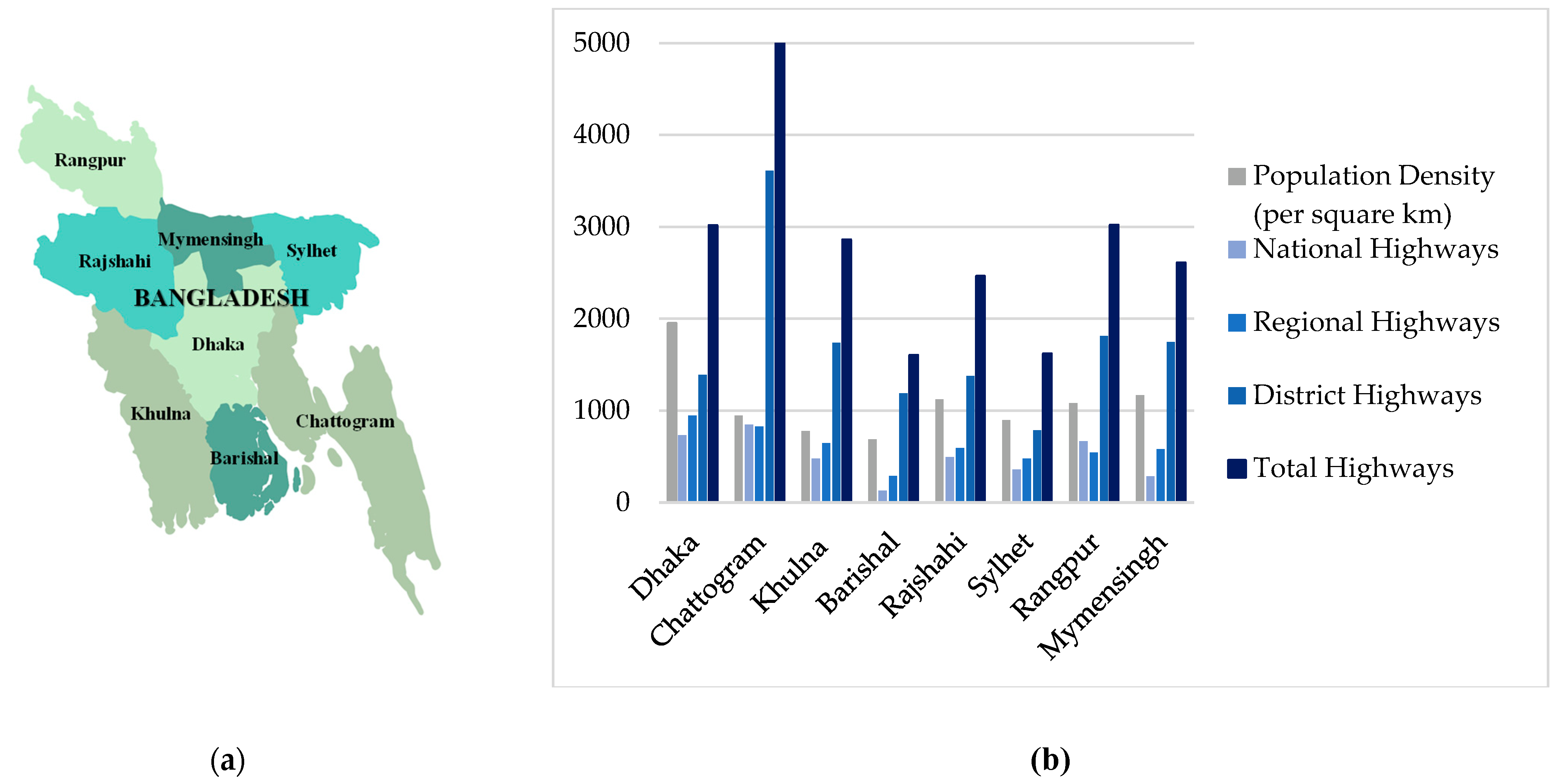
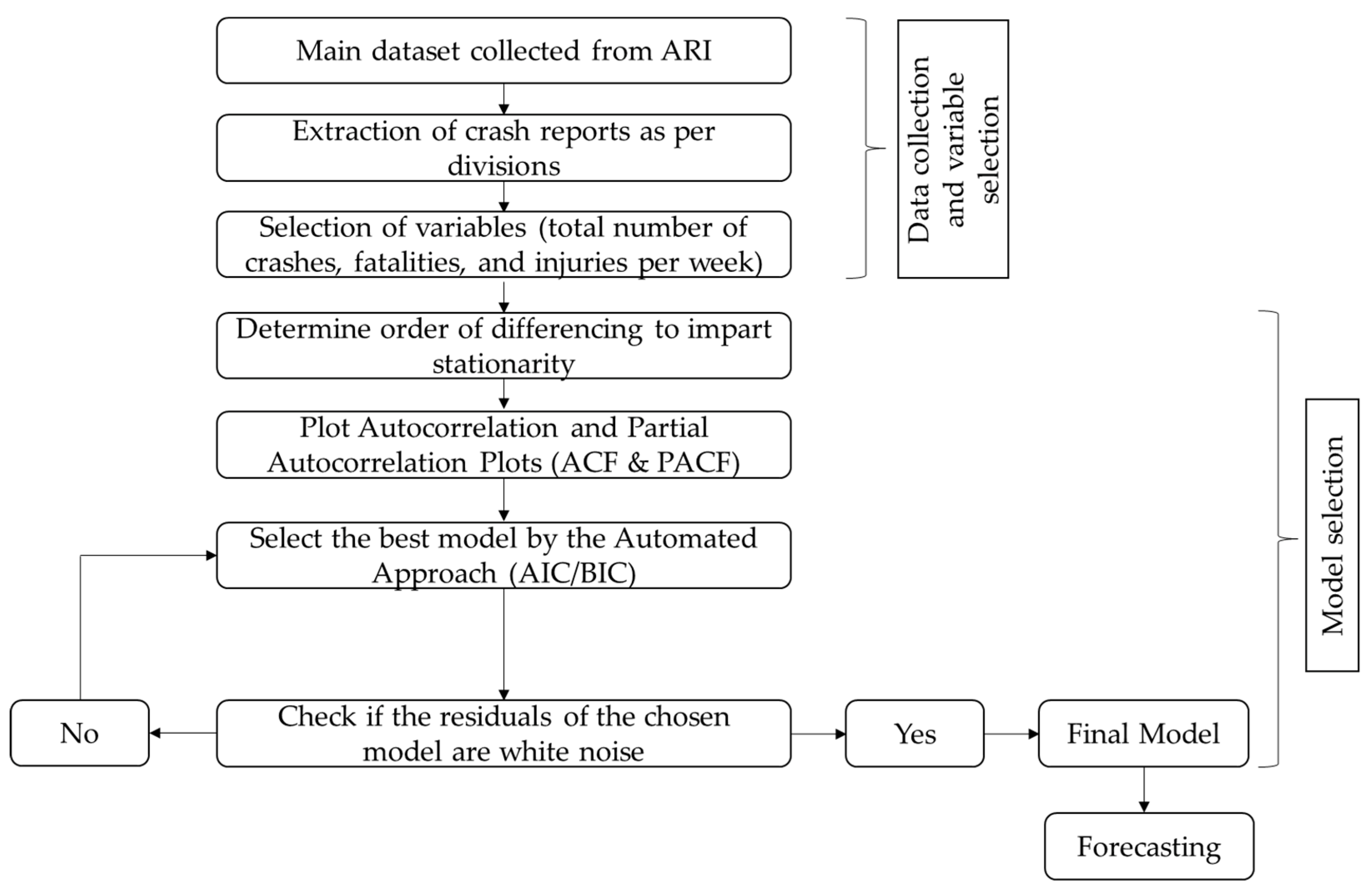











| Division | Crashes | Injuries | Fatalities |
|---|---|---|---|
| Dhaka | 3784 | 6503 | 6745 |
| Chattogram | 2227 | 3673 | 4356 |
| Khulna | 684 | 1055 | 1402 |
| Barishal | 897 | 1422 | 1887 |
| Rajshahi | 1930 | 3041 | 3410 |
| Sylhet | 684 | 1055 | 1402 |
| Rangpur | 1358 | 2404 | 2223 |
| Mymensingh | 907 | 1374 | 1686 |
| Before Lockdown | During Lockdown | ||||||||
|---|---|---|---|---|---|---|---|---|---|
| Data | Minimum | Median | Mean | Maximum | Minimum | Median | Mean | Maximum | |
| Dhaka | Crash | 4.00 | 16.00 | 16.83 | 40.00 | 4.00 | 7.00 | 8.20 | 20.00 |
| Injury | 0.00 | 23.00 | 29.11 | 219.00 | 4.00 | 7.50 | 9.90 | 25.00 | |
| Fatality | 0.00 | 20.00 | 30.30 | 208.00 | 0.00 | 6.00 | 8.00 | 22.00 | |
| Chattogram | Crash | 0.00 | 8.00 | 8.46 | 25.00 | 2.00 | 7.50 | 7.00 | 10.00 |
| Injury | 0.00 | 13.00 | 16.47 | 105.00 | 0.00 | 5.50 | 4.90 | 8.00 | |
| Fatality | 0.00 | 13.00 | 19.53 | 96.00 | 0.00 | 0.50 | 5.90 | 27.00 | |
| Khulna | Crash | 0.00 | 3.00 | 2.99 | 10.00 | 0.00 | 2.50 | 2.60 | 5.00 |
| Injury | 0.00 | 3.00 | 4.66 | 44.00 | 0.00 | 3.00 | 3.10 | 7.00 | |
| Fatality | 0.00 | 3.00 | 6.27 | 55.00 | 0.00 | 0.00 | 2.20 | 13.00 | |
| Barishal | Crash | 0.00 | 4.00 | 3.94 | 13.00 | 1.00 | 2.50 | 3.00 | 6.00 |
| Injury | 0.00 | 4.00 | 6.33 | 93.00 | 1.00 | 3.00 | 2.90 | 5.00 | |
| Fatality | 0.00 | 4.00 | 8.44 | 71.00 | 0.00 | 0.50 | 3.00 | 9.00 | |
| Rajshahi | Crash | 0.00 | 8.00 | 8.46 | 25.00 | 2.00 | 7.50 | 7.00 | 10.00 |
| Injury | 0.00 | 10.00 | 13.45 | 70.00 | 2.00 | 8.50 | 8.30 | 13.00 | |
| Fatality | 0.00 | 10.00 | 15.18 | 147.00 | 0.00 | 6.50 | 7.00 | 15.00 | |
| Sylhet | Crash | 0.00 | 3.00 | 2.99 | 10.00 | 0.00 | 2.50 | 2.60 | 5.00 |
| Injury | 0.00 | 3.00 | 4.66 | 44.00 | 0.00 | 3.00 | 3.10 | 7.00 | |
| Fatality | 0.00 | 3.00 | 6.27 | 55.00 | 0.00 | 0.00 | 2.00 | 13.00 | |
| Rangpur | Crash | 0.00 | 6.00 | 5.973 | 17.00 | 1.00 | 5.00 | 4.40 | 7.00 |
| Injury | 0.00 | 7.00 | 10.65 | 143.00 | 1.00 | 5.00 | 6.10 | 18.00 | |
| Fatality | 0.00 | 5.50 | 9.90 | 86.00 | 0.00 | 1.50 | 4.60 | 17.00 | |
| Mymensingh | Crash | 0.00 | 4.00 | 3.99 | 19.00 | 0.00 | 3.50 | 2.90 | 6.00 |
| Injury | 0.00 | 4.00 | 6.08 | 68.00 | 0.00 | 4.00 | 3.60 | 7.00 | |
| Fatality | 0.00 | 3.00 | 7.59 | 83.00 | 0.00 | 0.00 | 1.60 | 7.00 | |
| Divisions | Crashes | Injuries | Fatalities | ||||||
|---|---|---|---|---|---|---|---|---|---|
| Model | AIC | BIC | Model | AIC | BIC | Model | AIC | BIC | |
| Dhaka | (2,1,2) (1,1,1) [52] | 1133.27 | 1155.10 | (1,0,1) (1,1,1) [52] | 1645.34 | 1660.96 | (2,1,2) (0,1,0) [52] | 1694.87 | 1710.47 |
| Chattogram | (0,1,4) (1,1,0) [52] | 1004.65 | 1023.35 | (4,1,1) (1,1,0) [52] | 1470.52 | 1492.35 | (1,1,1) (0,1,0) [52] | 1568.21 | 1577.57 |
| Khulna | (4,1,1) (1,1,0) [52] | 779.97 | 801.79 | (1,0,2) (0,1,0) [52] | 1230.67 | 1243.17 | (2,1,1) (0,1,0) [52] | 1317.83 | 1330.30 |
| Barishal | (2,1,0) (1,1,0) [52] | 892.16 | 904.63 | (0,0,0) (0,1,0) [52] | 1441.10 | 1444.23 | (2,1,1) (0,1,0) [52] | 1357.09 | 1372.68 |
| Rajshahi | (0,1,4) (1,1,0) [52] | 1004.65 | 1023.35 | (5,1,1) (1,1,0) [52] | 1383.40 | 1408.34 | (0,1,1) (1,1,0) [52] | 1519.76 | 1529.11 |
| Sylhet | (4,1,1) (1,1,0) [52] | 779.97 | 801.80 | (1,0,2) (0,1,0) [52] | 1230.67 | 1243.17 | (2,1,1) (0,1,0) [52] | 1317.83 | 1330.30 |
| Rangpur | (0,1,1) (0,1,1) [52] | 910.38 | 919.73 | (0,0,0) (1,1,0) [52] | 1491.94 | 1498.19 | (2,1,1) (0,1,0) [52] | 1445.16 | 1457.64 |
| Mymensingh | (1,1,0) (1,1,1) [52] | 912.49 | 924.97 | (1,0,0) (0,1,0) [52] | 1353.71 | 1359.95 | (3,1,3) (1,1,0) [52] | 1393.85 | 1418.80 |
| Divisions | Crashes | Injuries | Fatalities | ||||||
|---|---|---|---|---|---|---|---|---|---|
| Error Estimates | ME | RMSE | MAE | ME | RMSE | MAE | ME | RMSE | MAE |
| Dhaka | −16.53 | 17.89 | 16.53 | −13.19 | 16.45 | 15.41 | −46.70 | 50.07 | 46.70 |
| Chattogram | −5.17 | 6.40 | 5.19 | −11.70 | 12.51 | 11.70 | −21.30 | 23.74 | 21.30 |
| Khulna | −2.16 | 3.09 | 2.51 | −0.39 | 2.99 | 2.20 | −6.82 | 13.65 | 10.38 |
| Barishal | 0.10 | 1.96 | 1.48 | −1.10 | 3.08 | 2.50 | −9.28 | 9.98 | 9.28 |
| Rajshahi | −5.17 | 6.40 | 5.20 | −5.82 | 7.77 | 6.04 | −15.75 | 25.58 | 16.84 |
| Sylhet | −2.16 | 3.09 | 2.51 | −0.39 | 2.99 | 2.20 | −6.82 | 13.65 | 10.38 |
| Rangpur | −3.25 | 4.52 | 3.47 | −0.80 | 6.61 | 5.31 | 0.72 | 8.87 | 6.50 |
| Mymensingh | 0.17 | 2.30 | 1.95 | −1.48 | 3.51 | 2.32 | −5.17 | 7.32 | 5.70 |
Disclaimer/Publisher’s Note: The statements, opinions and data contained in all publications are solely those of the individual author(s) and contributor(s) and not of MDPI and/or the editor(s). MDPI and/or the editor(s) disclaim responsibility for any injury to people or property resulting from any ideas, methods, instructions or products referred to in the content. |
© 2023 by the authors. Licensee MDPI, Basel, Switzerland. This article is an open access article distributed under the terms and conditions of the Creative Commons Attribution (CC BY) license (https://creativecommons.org/licenses/by/4.0/).
Share and Cite
Islam, S.; Huq, A.S.; Iqra, S.H.; Tomal, R.S. Impacts of COVID-19 Pandemic Lockdown on Road Safety in Bangladesh. Sustainability 2023, 15, 2675. https://doi.org/10.3390/su15032675
Islam S, Huq AS, Iqra SH, Tomal RS. Impacts of COVID-19 Pandemic Lockdown on Road Safety in Bangladesh. Sustainability. 2023; 15(3):2675. https://doi.org/10.3390/su15032675
Chicago/Turabian StyleIslam, Shahrin, Armana Sabiha Huq, Sabah Hossain Iqra, and Raas Sarker Tomal. 2023. "Impacts of COVID-19 Pandemic Lockdown on Road Safety in Bangladesh" Sustainability 15, no. 3: 2675. https://doi.org/10.3390/su15032675
APA StyleIslam, S., Huq, A. S., Iqra, S. H., & Tomal, R. S. (2023). Impacts of COVID-19 Pandemic Lockdown on Road Safety in Bangladesh. Sustainability, 15(3), 2675. https://doi.org/10.3390/su15032675








